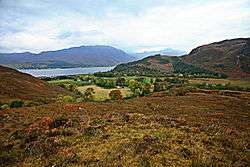Battle of Coille Bhan
| Battle of Coille Bhan | |||||||
|---|---|---|---|---|---|---|---|
| Part of the Scottish clan wars | |||||||
 Looking down onto the settlement of Attadale, with Loch Carron in the background | |||||||
| |||||||
| Belligerents | |||||||
| Clan Mackenzie | Colonel Kirk’s Regiment | ||||||
| Commanders and leaders | |||||||
|
Colonel Donald Murchison Kenneth Murchison | Captain McNeil | ||||||
| Strength | |||||||
| Unknown | 160 men | ||||||
| Casualties and losses | |||||||
| Unknown |
several wounded 1 killed | ||||||
The Battle of Coille Bhan (Scottish Gaelic for White Wood) was fought in 1721 near Attadale, in the county of Ross in the Scottish Highlands. It was fought between a British government force against Highlanders of the Clan Mackenzie.[1][2]
Background
The Battle of Coille Bhan followed on from the Battle of Glen Affric in 1721 when government forces had failed to take the lands of Mackenzie of Seaforth. The taxes being collected by Mackenzie’s factor, Donald Murchison were being sent to Mackenzie himself who was living in exile in France for his part in the Jacobite Rising of 1715, rather than the taxes going to the British crown.[1] It was decided that a second attempt should be made to seize Mackenzie of Seaforth’s estates.[1]
This time 160 soldier’s of Colonel Kirk’s regiment left Inverness under the command of Captain McNeil who had previously served in the Highland Watch regiment.[1] Unlike their predecessors who had been ambushed in Glen Affric, McNeil took a longer but easier route, from to Inverness to Dingwall, Strath-garve, and Loch Carron.[1]
Mackenzie’s force were led by Colonel Donald Murchison who had been in command at the previous conflict in Glen Affric.[1] Donald Murchison marched his main force to the top of Mam Attadale while a relative of his, Kenneth Murchison went forward with 13 men, all armed with muskets to prepare for an ambush at Coille Bhan (White Wood).[1]
The battle
Captain McNeil with 18 men of his government force advanced on Kenneth Murchison’s position.[1] They received fire in which several of the government troops were wounded and one was killed.[1] However, McNeil persisted in attacking his enemy and eventually he defeated them and Kenneth Murchison’s men withdrew, as they were unable to resist any further.[1]
However, although Captain McNeil had defeated this advance force, he soon heard of the larger group of Mackenzies waiting at Attadale under the command of Donald Murchison.[1] As a result, McNeil and his men returned to Inverness.[1]
Aftermath
No further attempts were made on Mackenzie of Seaforth’s lands.[1]
General George Wade, in his report to the King in 1725, stated that the Mackenzie of Seaforth tenants, who were formerly reputed to be the richest of any in the Highlands, had now become poor, by neglecting their business, and applying themselves to the use of arms.[1] "The rents" he says, "continue to be collected by one Donald Murchison, a servant of the late Earl's, who annually remits or carries the same to his master in France. The tenants, when in a condition, are said to have sent him free gifts in proportion to their circumstances, but are now a year and a-half in arrear of rent”.[1]
William Mackenzie, 5th Earl of Seaforth did not return from exile in France to Scotland until 1726.[1]